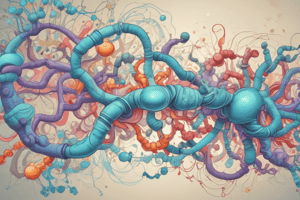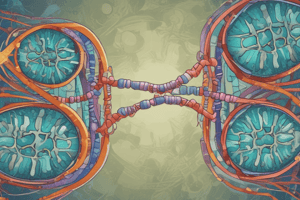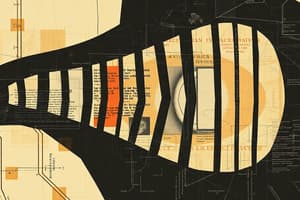Podcast
Questions and Answers
What is primarily responsible for the removal of introns from pre mRNA?
What is primarily responsible for the removal of introns from pre mRNA?
- RNA polymerase
- Ribosomes
- Endoplasmic reticulum
- Spliceosome (correct)
Which component of the spliceosome first recognizes the 5' splice site?
Which component of the spliceosome first recognizes the 5' splice site?
- U2 snRNP
- U4 snRNP
- U1 snRNP (correct)
- U6 snRNP
What is the significance of alternative splicing in eukaryotic cells?
What is the significance of alternative splicing in eukaryotic cells?
- It leads to the production of multiple protein products (correct)
- It allows the degradation of mRNA
- It permanently deletes certain exons
- It prevents intron removal
Which codon serves as the start codon during protein synthesis?
Which codon serves as the start codon during protein synthesis?
What type of RNA is involved in matching amino acids to codons in mRNA?
What type of RNA is involved in matching amino acids to codons in mRNA?
Which of the following statements about intracellular compartments is incorrect?
Which of the following statements about intracellular compartments is incorrect?
What is the role of specific enzymes in relation to tRNAs during protein synthesis?
What is the role of specific enzymes in relation to tRNAs during protein synthesis?
What happens to mature eukaryotic mRNAs after they are exported from the nucleus?
What happens to mature eukaryotic mRNAs after they are exported from the nucleus?
What is the primary function of lysosomes within the cell?
What is the primary function of lysosomes within the cell?
How do proteins enter the nucleus?
How do proteins enter the nucleus?
Which component of the nuclear envelope provides structural support?
Which component of the nuclear envelope provides structural support?
What structural component functions as the site of intron removal during mRNA splicing?
What structural component functions as the site of intron removal during mRNA splicing?
What is the primary role of the 5' methylated guanosine cap in eukaryotic mRNAs?
What is the primary role of the 5' methylated guanosine cap in eukaryotic mRNAs?
What is the role of RAN in nuclear transport?
What is the role of RAN in nuclear transport?
What is the purpose of splicing in the processing of eukaryotic mRNAs?
What is the purpose of splicing in the processing of eukaryotic mRNAs?
The sorting of endocytosed material is primarily performed by which organelle?
The sorting of endocytosed material is primarily performed by which organelle?
During the transcription process, which transcription factor first binds to the TATA box?
During the transcription process, which transcription factor first binds to the TATA box?
Which organelle is primarily responsible for the synthesis of ATP and carbon fixation?
Which organelle is primarily responsible for the synthesis of ATP and carbon fixation?
What is a characteristic feature of nuclear localization signals?
What is a characteristic feature of nuclear localization signals?
What is the primary function of the Golgi apparatus in relation to proteins?
What is the primary function of the Golgi apparatus in relation to proteins?
What is the result of incorrect splicing of mRNA?
What is the result of incorrect splicing of mRNA?
Which factor is crucial in the initiation phase of eukaryotic transcription?
Which factor is crucial in the initiation phase of eukaryotic transcription?
Which enzyme is responsible for adding the poly A tail to the 3' end of eukaryotic mRNA?
Which enzyme is responsible for adding the poly A tail to the 3' end of eukaryotic mRNA?
What is a major function of the poly A tail in mRNA?
What is a major function of the poly A tail in mRNA?
Flashcards are hidden until you start studying
Study Notes
Introns
- Introns are removed from pre-mRNAs by RNA splicing.
- Intron 5' ends start with GV and terminate with AG at the 3' end.
- Sequences adjacent to the 3' and 5' ends of the intron tend to be similar.
- Branch point near the 3' end contains an A residue. L
Spliceosome
- Intron removal is catalyzed by the spliceos ome.
- The spliceosome is made up of 5 types of RNA and more than 200 proteins.
- The spliceosome assembles from snRNPs (small nuclear ribonucleoprotein complexes).
- Each snRNP contains 1 or 2 snRNAs (small nuclear RNAs).
Spliceosome Assembly
- Spliceosome assembly involves the sequential binding of snRNPs to pre-mRNA.
- U1 recognizes the 5' splice site.
- U2 binds to the branch point sequence.
- U4/U6 and U5 bring the intron ends together.
- Pre-mRNA is cleaved at the 5' splice site and joined to the branch point A residue, forming a lariat.
- The 3' splice site is cleaved, and the two ends of the exon are joined together.
Alternative Splicing
- Introns allow pre-mRNA to be spliced in multiple ways.
- This leads to the production of multiple protein products.
- Different mechanisms can activate or skip certain splice sites.
From RNA To Protein
- mRNA synthesis takes place in the nucleus.
- Mature eukaryotic mRNAs are exported from the nucleus.
- mRNA is single-stranded RNA involved in protein synthesis.
- mRNA molecules are eventually degraded in the cytosol (cytoplasm).
- The mRNA sequence is decoded into sets of three nucleotides (codons).
- tRNA molecules match amino acids to codons in mRNA.
- Specific enzymes couple tRNAs to the correct amino acid.
From DNA to RNA
- Eukaryotic mRNAs are processed in the nucleus.
- 5' capping involves adding a methylated guanosine cap.
- Polyadenylation involves adding a 3' poly A tail.
- Splicing removes introns.
- RNA polymerase II phosphorylation is coupled to pre-mRNA processing.
- The 5' cap protects RNA from nucleases and plays a role in positioning RNA on the ribosome for translation initiation.
- The poly A tail protects mRNA from nucleases and is required for export of the transcript from the nucleus.
Protein Coding Genes
- Protein coding genes are interrupted by non-coding introns.
- Exons are coding sequences.
- Introns are non-coding sequences.
Intracellular Compartments and Protein Transport
- The main function of membrane-enclosed organelles of eukaryotic cells is compartmentalization.
- The cytosol contains many metabolic pathways, protein synthesis, and the cytoskeleton.
- The nucleus contains the main genome DNA and RNA synthesis.
- The endoplasmic reticulum (ER) synthesizes mRNA for all protein coding genes, miRNA genes, and other non-coding RNAs.
- RNA polymerase III transcribes non-coding RNAs in eukaryotic cells, including tRNA genes, 5s rRNA genes, and genes for many other small RNAs.
Transcription Initiation
- Initiation begins when RNA polymerase binds to the promoter sequence.
- RNA polymerase requires general transcription factors (TFs) such as TFIIB and TFIID.
- The TATA box is a DNA sequence that signals where the genetic sequence can be read and decoded.
- The TFIIB recognition element (BRE) is slightly upstream of the TATA box.
- The downstream promoter element (DPE) is 30 nucleotides downstream from the start site.
- TFIID binds to the TATA box via its TATA-binding protein subunit.
- TFIIB forms a complex with TFIID.
- The rest of the GTFs and RNA Pol II bind to the complex.
- The TATA-binding protein binds to DNA.
- TFIIH unwinds the DNA and phosphorylates RNA Pol II.
- RNA Pol II is released and transcription begins.
Nuclear Envelope
- The nuclear envelope separates the nucleus from the rest of the cell.
- The inner and outer membranes are separated by the perinuclear space.
- The outer membrane is continuous with the ER.
- The nuclear lamina supports the nuclear envelope and is composed of lamins.
- The nuclear envelope is perforated with nuclear pores, which are specialized channels where the inner and outer membranes are fused.
- These channels allow the exchange of molecules between the nucleus and the cytoplasm.
- Proteins are imported into the nucleus through nuclear pores.
Nuclear Import
- Proteins responsible for copying DNA, synthesizing RNAs needed for assembling ribosomes, and other proteins are transported into the nucleus.
- Over 5000 molecules are imported through the 2000-5000 nuclear pores every second.
- Nuclear localization signals (NLSs) are required for importing proteins into the nucleus.
- NLSs are usually 8-30 amino acids long.
- They often contain proline and basic amino acids such as lysine and arginine.
Hydrolysis-Driven Nuclear Transport
- Ran is a small GTPase that plays a role in nuclear transport.
- Ran-GDP is found in the cytoplasm, and Ran-GTP is found in the nucleus.
- GTP bound to Ran is hydrolyzed to GDP by Ran GAP (Ran GTPase activating protein) in the cytoplasm.
- GDP bound to Ran is exchanged for GTP by Ran GEF (Ran guanine nucleotide exchange factor) in the nucleus.
- This cycle of GTP hydrolysis and exchange drives the transport of proteins into and out of the nucleus.
ER
- The ER is a network of membrane-bound sacs and tubules that is involved in lipid synthesis, protein synthesis, and distribution of proteins to other organelles and the plasma membrane.
Golgi Apparatus
- The Golgi apparatus modifies, sorts, and packages proteins and lipids for secretion or delivery to other organelles.
Lysosomes
- Lysosomes are responsible for intracellular degradation.
Endosomes
- Endosomes are involved in the sorting of endocytosed material.
Mitochondria
- Mitochondria carry out ATP synthesis by oxidative phosphorylation.
Chloroplasts
- Chloroplasts are responsible for ATP synthesis and carbon fixation by photosynthesis.
Peroxisomes
- Peroxisomes are involved in the oxidative breakdown of toxic molecules.
Protein Sorting
- Proteins are transported into organelles by three mechanisms:
- Signal sequences direct proteins to the correct compartment.
- Proteins enter the nucleus through nuclear pores.
- Signal sequences often reside at the N-terminus or C-terminus of a protein.
Studying That Suits You
Use AI to generate personalized quizzes and flashcards to suit your learning preferences.




